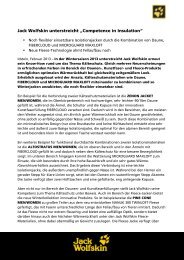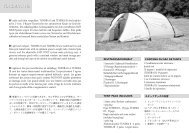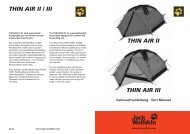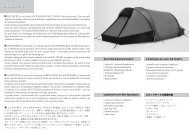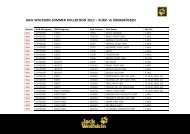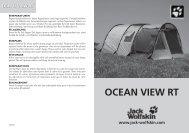The ZDHC Joint Roadmap - Jack Wolfskin
The ZDHC Joint Roadmap - Jack Wolfskin
The ZDHC Joint Roadmap - Jack Wolfskin
Create successful ePaper yourself
Turn your PDF publications into a flip-book with our unique Google optimized e-Paper software.
SECTION 2<br />
Our Strategy<br />
<strong>The</strong> <strong>Joint</strong> <strong>Roadmap</strong>, Version 2, is based on the learnings, experience and stakeholder feedback obtained<br />
during the first year of the <strong>ZDHC</strong> Programme. This section outlines the overall strategy, which includes the<br />
vision, mission and 2020 goals and how these goals translate into the work we are delivering.<br />
2.1 Vision Statement<br />
We envision an apparel and footwear industry that delivers high quality products, using safe chemistries,<br />
operating in ways that keep communities free from unintended, downstream environmental impacts. Further,<br />
our vision includes delivery to a market in which sustainable chemistry practices are preferred and rewarded,<br />
and the entire system of suppliers, brands, governments and NGOs also will fulfill their responsibilities to<br />
ensure the safe use of chemicals.<br />
2.2 Mission Statement<br />
<strong>The</strong> <strong>ZDHC</strong> Programme and its multi‐stakeholder group of partners will transform the global apparel and<br />
footwear industry by improving environmental performance and chemical safety; thereby delivering a safer<br />
and cleaner environment as we work towards zero discharge of hazardous chemicals in the life cycle of all<br />
products by 2020.<br />
2.3 2020 Goals<br />
<strong>The</strong> <strong>ZDHC</strong> Programme is working towards achieving the following by 2020:<br />
1. Elimination or substitution of hazardous chemicals in our members’ products and their manufacture<br />
2. Development of a transparent process to screen and eliminate hazardous chemicals in the apparel and<br />
footwear industry<br />
3. Tools training and capacity building programmes in place to support the entire supply chain<br />
4. Development of common, harmonised assessment tools to be used throughout the industry and clear<br />
guidelines on best practices available for all supply chain stakeholders<br />
5. Development of a system of disclosure, created in partnership with the supply chain, that allows<br />
communities and consumers to access information about potential exposures to chemicals<br />
6. <strong>The</strong> entire system of suppliers, brands, governments, and NGOs is engaged and participating, innovating,<br />
and fulfilling their respective responsibilities to ensure the safe use of chemicals.<br />
7. Development of a transparent and continuous stakeholder engagement process, that helps build trust and<br />
ensures strong alignment amongst all parties<br />
<strong>The</strong>se seven goals are aspirational and long‐term in nature. To ensure that we make practical progress, we<br />
developed tracks of work, which we call workstreams, to support progress towards the 2020 goals. While we<br />
do not know the details of the entire path towards achieving our 2020 goals, the workstreams are designed to<br />
help us learn, make progress, create measurable results and reassess as needed. To balance short‐ and<br />
long‐term thinking, we developed a set of interim 2015 achievements, and near‐term actions for each<br />
workstream.<br />
2.4 Interim Achievements<br />
Interim programme achievements are noted in Table 2‐1.<br />
2-1



